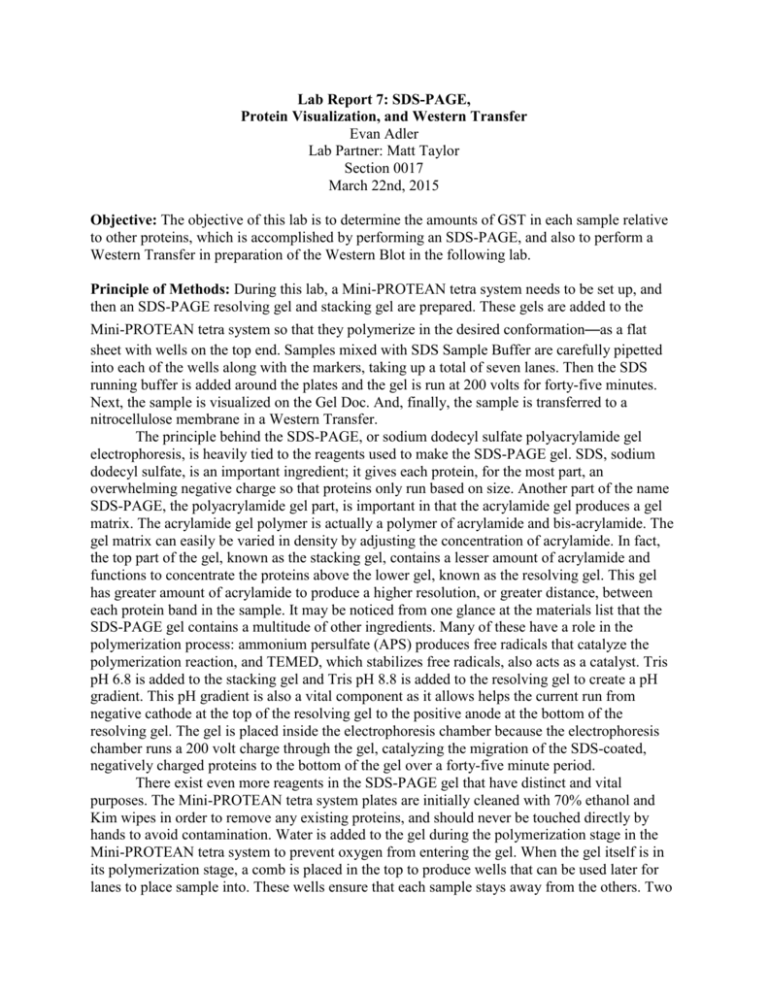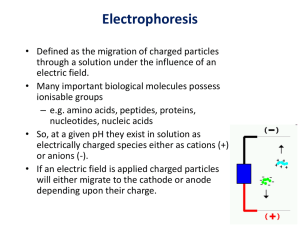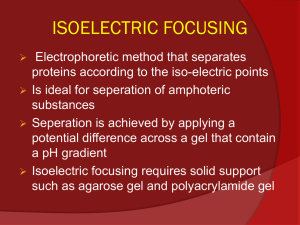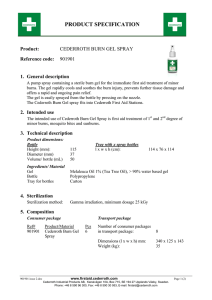Lab Report 7: SDS-PAGE, Protein Visualization
advertisement

Lab Report 7: SDS-PAGE, Protein Visualization, and Western Transfer Evan Adler Lab Partner: Matt Taylor Section 0017 March 22nd, 2015 Objective: The objective of this lab is to determine the amounts of GST in each sample relative to other proteins, which is accomplished by performing an SDS-PAGE, and also to perform a Western Transfer in preparation of the Western Blot in the following lab. Principle of Methods: During this lab, a Mini-PROTEAN tetra system needs to be set up, and then an SDS-PAGE resolving gel and stacking gel are prepared. These gels are added to the Mini-PROTEAN tetra system so that they polymerize in the desired conformation—as a flat sheet with wells on the top end. Samples mixed with SDS Sample Buffer are carefully pipetted into each of the wells along with the markers, taking up a total of seven lanes. Then the SDS running buffer is added around the plates and the gel is run at 200 volts for forty-five minutes. Next, the sample is visualized on the Gel Doc. And, finally, the sample is transferred to a nitrocellulose membrane in a Western Transfer. The principle behind the SDS-PAGE, or sodium dodecyl sulfate polyacrylamide gel electrophoresis, is heavily tied to the reagents used to make the SDS-PAGE gel. SDS, sodium dodecyl sulfate, is an important ingredient; it gives each protein, for the most part, an overwhelming negative charge so that proteins only run based on size. Another part of the name SDS-PAGE, the polyacrylamide gel part, is important in that the acrylamide gel produces a gel matrix. The acrylamide gel polymer is actually a polymer of acrylamide and bis-acrylamide. The gel matrix can easily be varied in density by adjusting the concentration of acrylamide. In fact, the top part of the gel, known as the stacking gel, contains a lesser amount of acrylamide and functions to concentrate the proteins above the lower gel, known as the resolving gel. This gel has greater amount of acrylamide to produce a higher resolution, or greater distance, between each protein band in the sample. It may be noticed from one glance at the materials list that the SDS-PAGE gel contains a multitude of other ingredients. Many of these have a role in the polymerization process: ammonium persulfate (APS) produces free radicals that catalyze the polymerization reaction, and TEMED, which stabilizes free radicals, also acts as a catalyst. Tris pH 6.8 is added to the stacking gel and Tris pH 8.8 is added to the resolving gel to create a pH gradient. This pH gradient is also a vital component as it allows helps the current run from negative cathode at the top of the resolving gel to the positive anode at the bottom of the resolving gel. The gel is placed inside the electrophoresis chamber because the electrophoresis chamber runs a 200 volt charge through the gel, catalyzing the migration of the SDS-coated, negatively charged proteins to the bottom of the gel over a forty-five minute period. There exist even more reagents in the SDS-PAGE gel that have distinct and vital purposes. The Mini-PROTEAN tetra system plates are initially cleaned with 70% ethanol and Kim wipes in order to remove any existing proteins, and should never be touched directly by hands to avoid contamination. Water is added to the gel during the polymerization stage in the Mini-PROTEAN tetra system to prevent oxygen from entering the gel. When the gel itself is in its polymerization stage, a comb is placed in the top to produce wells that can be used later for lanes to place sample into. These wells ensure that each sample stays away from the others. Two of the lanes are filled with markers. There are two types of markers; one lane contains dual-color markers and the other contains unstained markers. The dual-color markers appear as bright fluorescent orange bands while the unstained markers are only faint bands. Both types of markers contain easily obtainable proteins at known molecular weights; in this case there are 25kDa and 75kDa proteins in each marker. Two other lanes will be filled with bovine serum albumin, or BSA, and lysozyme to provide additional relative markers in the gel. BSA should appear at 66.5kDa and lysozyme should appear at 14.7kDa. The remaining three lanes will be filled with normalized samples from prior labs. The sample from the SEC, lysate, and IEX are all normalized to the least common protein concentration so that every lane runs the same amount of protein. In this way, it is possible to compare each of the relative protein sizes and amounts. To prepare the sample, beside normalization, which was already discussed, each sample is treated with a number of reagents. One of these, beta-mercaptoethanol, dissolves disulfide bridges in the protein sample. The samples are also boiled on the heat block to denature the proteins and dissociate any weak bonds. The addition of these reagents ensures that the protein is broken up into smaller parts when it’s run through the SDS-PAGE gel. A tracking dye, bromophenol blue, is additionally added to the sample for a number of reasons. First, it allows one to see where the protein is when it is pipetted into the well. For this step, it is important that the protein is inserted into the right area, the well, instead of between well or outside the well altogether. These mistakes may seem farfetched by it is easier to do than it may sound. Next, the tracking dye allows the researcher to see when electrophoresis is complete. The tracking dye will travel down the gel faster than any protein because it is smaller than any protein, and so when the dye hits the bottom it is an indication to stop electrophoresis. Moreover, glycerol is added to the sample to make it denser so that the sample runs down the gel better. 2,2,2-trichloroethanol, or TCE, is added to the mix for protein visualization. When TCE reacts with the tryptophans in protein while under the presence of UV light it produces a fluorescent glow. This technique of TCE has distinct advantages over other methods of protein visualization: it is quick, accurate to 0.2 micrograms of proteins, relatively cheap, and allows for downstream applications with the gel. In contrast, Coomassie blue staining is a common method that is as accurate and similarly priced as the TCE method, but proteins are fixed to the gel rendering it unusable for downstream applications. Additionally, it takes an hour to perform, longer than the TCE method. Other methods of protein visualization offer their own benefits— silver staining and autoradiography are more accurate than TCE or Coomassie, but these methods are either much more expensive or take much longer. For these, reasons, TCE was chosen for this lab. When analyzing an SDS-PAGE gel visualized using TCE, the markers should be in the first and last lanes. The 25kDa marker should appear somewhere near the center of the gel as a fluorescent orange in the dual-color marker and a faint blue band in the unstained marker. The 75kDa marker on each of these should appear as a similar-looking band at the top of the gel. Heavier proteins, like the 75kDa marker, will migrate a shorter distance and will appear at the top of the gel while smaller proteins will appear lower on the gel. BSA, with a molecular weight of 66.5kDa, should appear very close to the 75kDa marker at the top of the gel. Lysozyme, with a molecular weight of 14.7kDa should be very near the bottom of the gel. The other samples, lysate, SEC and IEX will be a little more complicated. These proteins, in an ideal purification, should showcase a bright GST band accompanied by dim bands of other proteins, which are just other remaining E. coli proteins. An ideal progression would show the GST get gradually brighter as it is purified from lysate to SEC to IEX while background proteins get gradually dimmer. A brighter band indicates a greater relative purity while a dimmer band indicates a lesser relative purity. The marker proteins provide an easy way to determine the molecular weights of the proteins in each lane. Lastly, it should be noted that, since TCE is being used for visualization, not all protein bands will be visible since TCE is sensitive only to 0.2 micrograms. Also, as TCE does not bind specifically to GST, other proteins of similar molecular weight to GST will appear at around 26kDa. Finally, the principle underlying the Western Transfer is relatively straightforward. The goal of a Western Transfer is to transfer the proteins from the SDS-PAGE onto another membrane that can be used in the Western Blot for the following lab. The SDS-PAGE gel is placed in a sandwich between blotting paper and a nitrocellulose membrane. The nitrocellulose membrane has a very high affinity for proteins. To get the proteins from the SDS-PAGE gel to the nitrocellulose membrane, electrodes are attached to the membrane-gel sandwich in a buffer solution with a negative charge at the gel and a positive charge at the membrane. A perpendicular current is run through the electrodes, catalyzing the migration of the negatively charged proteins to the positive charge at the nitrocellulose membrane. After the transfer is complete, the membrane is ready for the Western Blot in the next lab. Materials: • Normalized lysate sample • Normalized SEC sample • Normalized IEX sample • 70% ethanol • Kim-Wipes • Mini-PROTEAN Tetra system (Large Plate, Spacers, Small plate, Green Casting Clamp, Clear Casting Frame) • 15ml conical tube • 1.5M Tris pH 8.8 • 30% Acrylamide Mix • 99% TCE • 10% SDS • 10% APS • TEMED • 0.5M Tris pH 6.8 • Comb • BSA • Lysozyme • Blue 10X SDS Sample Buffer (20ml 1M Tris pH 6.8, 5g SDS, 25ml glycerol, 50mg bromophenol blue, 1ml beta-mercaptoethanol, 3ml water). • Heat block • Electrophoresis center piece • Dual-Color Marker • Unstained Marker • • • • • • • Easypet Gel Doc UV transilluminator Blotting paper Western Transfer device Serological pipette Nitrocellulose membrane Results: Image 7-1: SDS-PAGE Lanes: Lanes: 1 2 3 4 5 6 7 Dual-Color Lysate SEC IEX BSA Lysozyme Unstained Marker Marker 1 2 3 4 75kDa Marker 25kDa Marker 5 6 7 75kDa Marker BSA GST GST GST 25kDa Marker Lysozyme Discussion: The objective of this lab is to determine the amounts of GST in each sample relative to other proteins, which is accomplished by performing an SDS-PAGE, and also to perform a Western Transfer in preparation of the Western Blot in the following lab. The methods for this process consist of readying the SDS-PAGE by making the stacking gel and the resolving gel, running the SDS-PAGE in the electrophoresis chamber, visualizing it, and transferring it to a nitrocellulose membrane for a Western Blot next week. The SDS-PAGE results are not as hard as they would seem to analyze. The 25kDa marker appears near the middle of the gel and the 75kDa marker near the top. The dual-color markers match up with their unstained marker counterparts. Both marker lanes contain a good amount of contamination. The unstained lane contains protein bands that are not at 25kDa or 75kDa, but, namely, the dual-color marker lane contains a vast amount of contamination below and above the markers, though the markers are still the brightest by far. The bottom of the SDSPAGE is thick with fluorescence. The lysozyme band appears right above this fluorescence at a molecular weight significantly lower than the 25kDa marker at a molecular weight that is hard to estimate. The BSA band appears a little distance below the 75kDa at around 60kDa. The lysate lane contains a bright GST band at 26kDa vague background E. coli protein bands above and below this GST band. The SEC land contains a less bright GST band at 26kDa and even dimmer background protein bands above and below it. Finally, the IEX lane contained the brightest GST band of them all at 26kDa but also the brightest background expression of the others above and below the GST band. The results in this SDS-PAGE seem to be pretty good. GST is where it would be expected to be, just above the 25kDa marker at about 26kDa. It is a bit difficult to determine how well the purification went from this information however. The lysate contains a considerable difference already in the amount of GST versus background proteins. It is hard, for this reason, to determine if purification has indeed occurred between the lysate step and the SEC step. As the SEC sample contains a less bright GST band and less bright background protein bands, it could really go either way. Upon comparison of these two bands, one thing is for certain: the lysate sample is dirtier, or contains more contaminants, than the SEC lane. This is as expected, since a purification did occur it would be reasonable to assume that less contaminants would be present in the SEC sample. The next lane, the IEX lane, contains promising results. The GST band is very bright here, even when compared to the brighter background proteins. This is the definitely the dirtiest lane so far, which is a bit puzzling, but it also contains the most marked difference is GST amount relative to background expression. It’s clear that this lane has the most GST relative to other proteins, which should be expected since this is the last step in the purification. However, it is strange that is should also be the dirtiest lane. Perhaps it was run differently than the other proteins on the gel—maybe in slightly different quantities—that resulted in a brighter expression of all of the protein bands in this sample. The markers did not run entirely as expected. It was obvious which protein bands in the markers were expected to carry the marker proteins: the bands at 25kDa and 75kDa were very prevalent in both the dual-color and unstained markers. The rest of the bands in the marker seem to only be attributable to contaminants in the purchased product. Indeed, it would not seem unreasonable for a company to produce an incomplete, and therefore less expensive, purification of the marker proteins if the marker proteins are still very apparent in the gel. BSA and lysozyme appear as anticipated on the gel. Lysozyme appears in a band that one would expect to be around its molecular weight of 14.7kDa. Similarly, BSA appears at a distance that, based on its proximity to the 75kDa marker, could likely be considered its molecular weight of 66.5kDa. Additionally, both of these lanes are free of contaminants, as it would be expected. The thick band of fluorescence at the bottom may have resulted from waiting a little too long to stop the electrophoresis. This fluorescence is likely just protein that ran into the bottom of the gel before the current was shut off. Overall, there were few and insignificant problems wit this SDS-PAGE. It indicates a successful purification, which was the primary goal. The markers were highly readable, though they contained contaminants. The lysozyme and BSA bands showed up at the correct positions, as well as the GST. And finally, the difference in brightness between GST and background E. coli proteins increased with each purification step, as one would expect if GST was really being purified each time. Source: Borgon, RA and Verity, N. (2013). Quantitative Biological Methods. Pearson.







